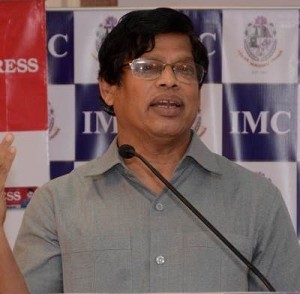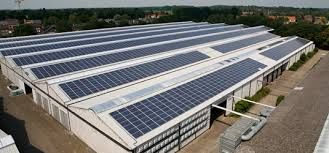Solar Power will trigger employment and economic growth
It was perhaps the most candid outline of what lies ahead for the solar power sector in India. Upendra Tripathy, secretary, Ministry of New and Renewable Energy, spoke of the big plans that lie ahead for this sector. He said this while delivering the keynote address at the FPJ-IMC Forum on Solar Energy: The Agony and the Ecstasy.
Tripathy began by pointing out the problem he had with the theme. “I did not understand the theme. . . . We find no agony in any of this.” And then began outlining the factors that make his ministry and his government quite exuberant about this sector.
True, he admitted, there was a period when nothing made sense. Nobody in the ministry knew how it would meet a target of 100 GW of solar power. Even today, with under 20 GW of capacity in the solar power sector over the past seven years, there were questions about the government’s ability to set up another 80 GW of capacity within the next six years. There was also the question about money. Who would finance the 80GW of solar capacity? At a cost of Rs 5 crore per MW of installed capacity, the total funding required could be as much as Rs 4 lakh crore.
But things began looking brighter when the ministry decided to hold a meeting with potential investors and seek out their interests. By the time the exercise was over, the ministry had commitments for 277,000 megawatts (277 GW). As Tripathy put it, “[We were now confronted with] a second challenge because what you do with 277,000 megawatt. You need only 100,000 megawatts.”
Then, there was a third challenge, “How do we tackle [the issue of] land?”
 But what the investor meet did was, “It brought in a number of companies together and they feel safe to participate in the process”, explained Tripathy. “And just three days ago, we got signed documents for commitment of the banks to give 77,000 megawatt financing. And we had a meeting with the chiefs of the banks, some 28 public sector banks, and we are so happy to say that the banks have met their objective. They have kept their promise. Some 20 percent of the money almost – that day Rs 88,000 crore they had given to the renewable energy sector.”
But what the investor meet did was, “It brought in a number of companies together and they feel safe to participate in the process”, explained Tripathy. “And just three days ago, we got signed documents for commitment of the banks to give 77,000 megawatt financing. And we had a meeting with the chiefs of the banks, some 28 public sector banks, and we are so happy to say that the banks have met their objective. They have kept their promise. Some 20 percent of the money almost – that day Rs 88,000 crore they had given to the renewable energy sector.”
These developments have given the ministry tremendous confidence.
As for land, “We brought experts, we got you know agencies which said land is not going to be a problem. And we said fine if land is going to be an issue 40,000 megawatt of this we’ll take out and put it in the rooftop which requires no land and that is how the finance minister is very comfortable with this idea that 40,000 megawatt out of 100,000 megawatt won’t require land,” said Tripathy.
This was the first time that the MNRE had announced that there would be no requirement of land for at least 40,000 (40 GW) of solar power!
“Then came the issue of capital, how do you get money? You can’t issue – we don’t have a very bond friendly market. There are no green bonds. There are no payment security mechanisms in place,” explained Tripathy. “But we have got brilliant support from the private sector banks. We have got excellent support from the public sector banks,” he said with a smile.
Then state governments came forward with their commitments. “I am proud to say that Karnataka today has some 2,000 megawatts, almost 10,000 acres of land, they have got through a society, which is leased out to the developers of the solar power system in there. And nothing was acquired or notified to that extent. It is just a farmers’ society they made, and they leased out the land to the park.” Indian jugaad (innovation) was at work. And one by one each problem was being knocked down.
The next problem on the anvil was manpower. “Do you have sufficient engineers? Do you have IPPs? Do you have the ECPs and do you have the trained mechanics, who can actually attend to whether your rooftop or solar part requirements?,” were the questions that Tripathy’s team came up with. After all, unlike the West, India has the problem of dust. Every alternate day or at least once a week you have to wash the equipment.
Another vexatious issue was the anti-dumping duty of 45 percent which had already been notified. The ministry knew that with the imposition of this duty, the achievement of 100 GW would become quite difficult. After all, India imports 73 percent from China and some 17 percent from Malaysia. The MNRE is working to get this waived.
And the biggest challenge was an internal milestone the ministry had set for itself. Although the Prime Minister had promised the nation that his government would move towards installing 100 GW of solar power by 2022, the ministry wanted to do this by 2020.
That was when the ministry came up with a plan to train 50,000 mechanics under a scheme called Surya Mitra. To get his service, the ministry would release an app which would allow you to call an engineer who would charge you Rs 150.
The ministry was also rewarded with an increase in its budget from Rs 1500 crore to Rs 9,000 crore – a six times’ increase within two years.
More good news followed. Carbon cess collections in India went up from Rs 50 crore to Rs 400 crore. Then the RBI allowed Rs 1,500 crore to be disbursed to this industry as priority sector lending. Thus, an investment of Rs 10 lakh for rooftop solar will be treated as priority sector lending.
Thus, while household rooftops will enjoy a subsidy, commercial and industrial rooftops won’t. This is because, as Tripathy explains, the tariff benefits for industry and the commercial sectors are immense. Hence, Delhi Metro has informed the MNRE that for “every unit of solar energy we take, we save around Rs 4”. It is now planning to produce 500 MW Madhya Pradesh and bring it to Delhi for the use of its metro services. Meanwhile the Chief Justice of the Supreme Court too has plans to source 100 percent of the court’s power requirement through solar power. The MNRE is working to extend this concept to all government buildings as well.
“We are now working on a scheme to finance 10,000 unemployed graduates, which would enable each to set up 1 MW of solar capacity. We want to make them solar entrepreneurs,” added Tripathy. Today, he is certain that his ministry has the confidence to set up 100 GW of power in eight months’ time – technically speaking. A lot will depend on how fast states will also move. This is because much of the new solar installations will come up as decentralised cluster power generation stations for remote and unconnected villages. This way, the state governments save costs on laying down transmission lines, reduce theft, and most importantly provide power to all before the turn of this decade.
There could be a small problem with urban or industrial rooftops, however. Unlike the US or Germany where household tariff is almost four to five times that of industrial tariffs (industry is subsidised), India has tariffs that work the other way. Industrial and household tariffs are higher than for farmer and economically weaker sections. If households and industry were to take up (cheaper) solar power, the state would lose its most lucrative customers which help it subsidise power for farmers and for economically weaker sections.
But with battery/storage costs plummeting, and solar panel costs going down, the era of decentralised, off-grid power is not far away. What happened to the telecom sector when mobile phones made copper wires redundant could happen to the power sector as well.
Moreover, as Tripathy says, “For every megawatt of solar that you put, you know, 50 vehicles go out of the road, 2 percent (of population) don’t die premature deaths, who otherwise die of (poor) air quality. So if you are an active partner; either a company, or a consultant, or anything that you are playing a role now in the solar revolution you should be feeling very proud of it.”











































COMMENTS